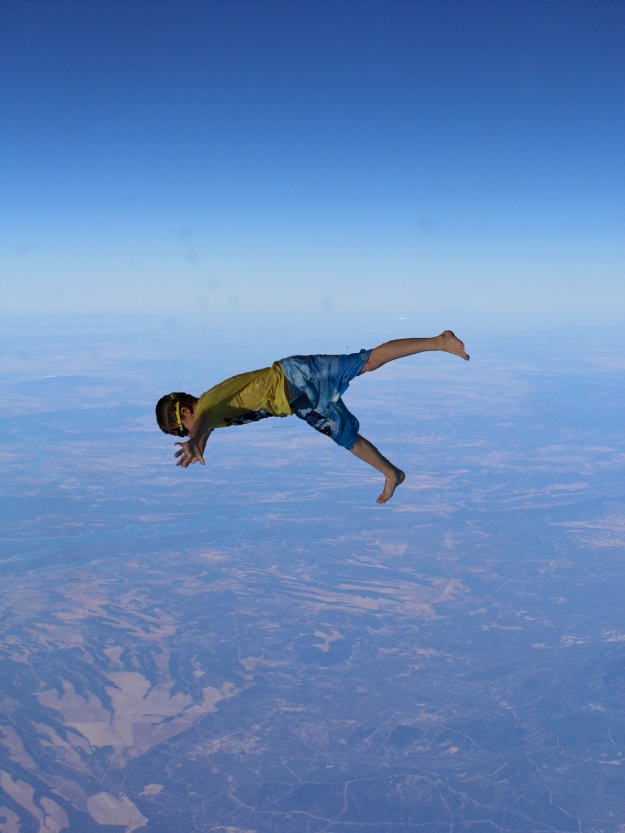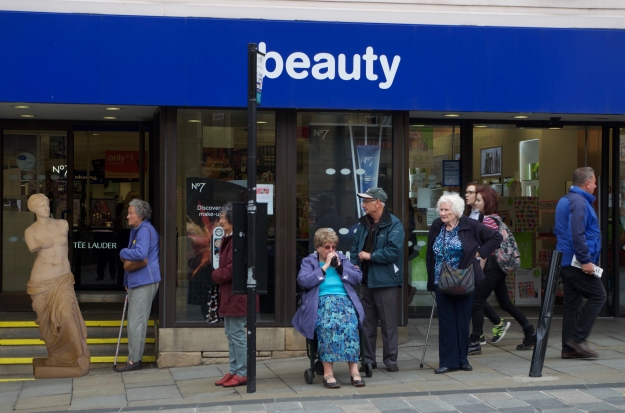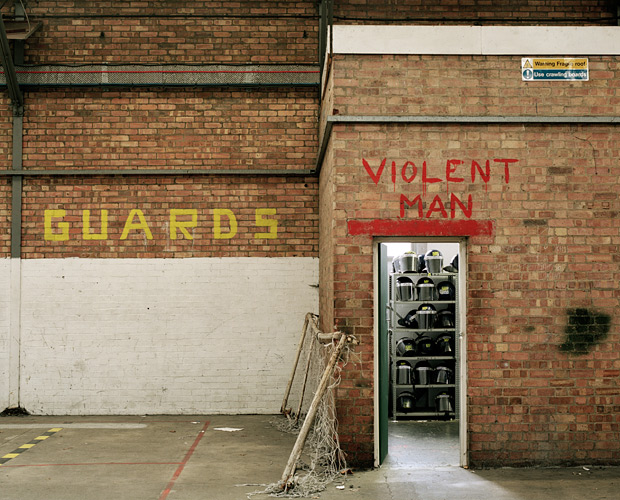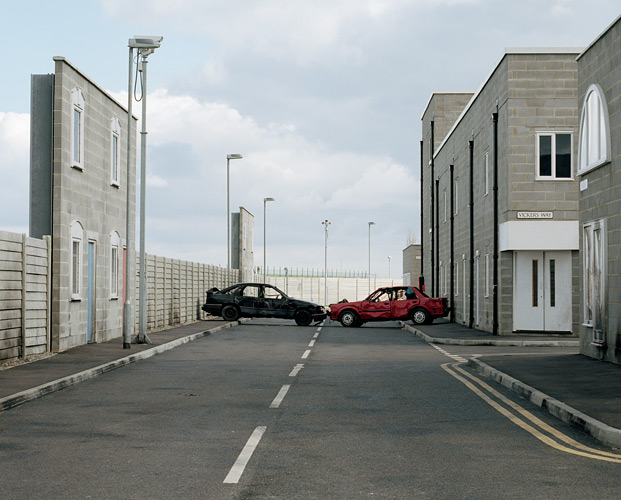

 I combined a picture of the sky from an aeroplane with a picture of my grandson jumping into a pool as a first attempt at this exercise. I need to work on keeping edges soft to make a more convincing image.
I combined a picture of the sky from an aeroplane with a picture of my grandson jumping into a pool as a first attempt at this exercise. I need to work on keeping edges soft to make a more convincing image.
Second attempt




 I combined a picture of the sky from an aeroplane with a picture of my grandson jumping into a pool as a first attempt at this exercise. I need to work on keeping edges soft to make a more convincing image.
I combined a picture of the sky from an aeroplane with a picture of my grandson jumping into a pool as a first attempt at this exercise. I need to work on keeping edges soft to make a more convincing image.


My first impression is of a film set for a dystopian future and then I thought that the set is too clean and artificial. the series is more like a record of a Stalin era training ground for spies than an actual training area of police or fire brigades in Northern Ireland. I wonder how effective the sets were and whether the trainees imagined themselves in episodes of The Prisoner. This is to say that despite the crashed cars, the images of burnt out buildings and so on, we are presented with a shocking reminder that no plan survives first contact with the enemy. We have all seen newsreel of actual riots, damage and destruction and it does not look like this.
On a personal note – I was a student in Paris in 1968-9. I saw riots, chaos and social disorder at first hand. I learned very quickly to run away from the CRS and their pickaxe handles. I see no hint of fear in Sarah Pickering’s images because we can see that the set is a sham. There is no evidence of tear gas, rubber bullets, blood, lost shoes, or water cannon.
If these images are a documentary about how to deal with social disorder their scope is too narrow to be effective. But they do say something about the openness of a society that can allow this kind of look behind the scenes. The context of the set is blurry and so is the narrative. this is not necessarily a bad thing. There is space for the viewer to reflect and make up their own mind about what they are being shown. Does the fact that the authorities gave permission for Sarah Pickering to take these photos and publish them indicate connivance or openness? I this why the scenes seem too clean?
Is this set of images misleading? I don’t think so. After all, there has to be something in front of the camera to make the image. However, the images are very carefully composed. Scenes are selected.
In this example, the two cars are central and at precisely the right distance from the camera to show the falsehood on the left and the presumed reality on the right of the picture. The photographic process contributes to the unreality and absurdity of the images and perhaps that is the point.
1. August Sander
Young Farmers 1914
Sanders made a classic portrait survey of German life in the 20s and 30s.
“His concept and method is almost a caricature of Teutonic methodology, and if it had been executed by a lesser artist the result might well have been another dreary typological catalogue. Sander, however, was a very great photographer. His sensitivity to individual subjects, to expression, gesture, posture and symbols seems unerringly precise. His pictures show two truths simultaneously and intentionally; the social abstraction of occupation and the individual who serves it. The masks reveal every bit as much as the face they attempt to hide.” (1)
I like this picture of the young farmers dressed in their Sunday best, carrying their fashionable canes, on their way to some event. The date makes it particularly poignant. These young men are, as the saying goes, ‘dressed to kill’, and the date implies that they will soon be called up to fight in the Great War.
The New York Times Obituary notice for Lewis Baltz quoted Baltz’s attitude to art photography – “I think being a photographer is a little like being a whore,” he once said, with characteristic dry wit. “If you’re really, really good at it, nobody will call you that.” (2)
Baltz belongs to the category of New Topographics, that is, those who find beauty in the banal, man-altered landscapes. (See also Bernd & Hilla Becher, Stephen Shore, Henry Wessel, Joe Deal, Robert Adams, Nicholas Nixon, Frank Gohlke.)
This picture makes me wonder what the architect of the building had in mind. They don’t seem to be concerned with the exterior of the building and one can only hope that the interior has something more than a utilitarian charm.
“There is very little on the outside that tells you what a person is really like on the inside”(3)
Everything in his images is constructed in advance. He says, “dramatising elements is what make it seem like a narrative.” The line between real and fictional is blurred in order to question the premise that when you see a photograph, you see the truth.
This image reminded me of Jack Vettriano’s painting, Cocktails and Broken Hearts.
In this case I wonder whether the realism of the photograph has any advantage over the
verismo of the painting.
Investigating the relationship between photography and realism, Eggleston is a democratic (demotic?) artist showing the world in colour in an attempt to show ‘what is’.
He said, “Well, probably the best way to put it might be that at some time, not just in an instant, but over some period of time I became aware of the fact that I wanted to document examples like Kroger or Piggly Wiggly in the late ’50s, early ’60s. I had the attitude that I would work with this present-day material and do the best I could to describe it with photography, not intending to make any particular comment about whether it was good or bad or whether I liked it or not. It was just there, and I was interested in it. That’s what I still do today.” (4)
So many of Egglestone’s images follow the ‘rule of thirds’ or have the subject dead centre that they seem too considered to tell the truth, the whole truth and nothing but the truth. They are too selective and composed for that. 

(1) http://www.amber-online.com/exhibitions/sander-collection/detail
(2) Quote taken from a conversation between Baltz and John Gossage.
http://www.americansuburbx.com/2011/03/interview-conversation-between-lewiz.html
(3) An interview with Philip-Lorca di Corcia https://www.youtube.com/watch?v=So_FK4qnz5Q
(4) An Interview with Harmony Korine 27 November 2008.
http://www.interviewmagazine.com/art/william-eggleston/#_
I walked through Durham City, spending most of my time in the Market Place, taking photographs as I went. The exercise was to take 30 black and white and 30 colour images in a street photography style. I actually took quite a few more.
I took all the images in RAW format and converted them when I got home. My criteria for converting from colour to black and white were:-
If I had not had the camera with me I’m sure I would have remembered very few specifics about this short walk. The act of taking a photograph has fixed the memory. Things I saw between taking photographs are already forgotten. I’m reminded of a line in Alpha House, a satire on the American Republican Party, when a reporter asks, “Do you mind if I tape this (conversation), otherwise it didn’t happen”, echoing David Campany’s comments on the mnemonic superiority of photographs.(1) Calvino expressed the same idea more forcibly: “It is only when they (the photographers) have the photos before their eyes that they seem to take tangible possession of the day they spent, only then that the mountain stream, the movement of the child with its pail, the glint of the sun on the wife’s legs take on an irrevocability of what has been and can no longer be doubted.”(2)
Why colour?
Meyerowitz shares his reasons [for] shooing [sic] in color– one of the main reasons being the emotions and sensations he got from the description of color:
Interviewer: Why are you using color?
Meyerowitz: Because it describes more things.
Interviewer: What do you mean by description?
Meyerowitz: When I say description, I don’t only mean mere fact and the cold accounting of things in the frame. I really mean the sensation I get from things—their surface and color—my memory of them in other conditions as well as their connotative qualities. Color plays itself out along a richer band of feelings—more wavelengths, more radiance, more sensation. I wanted to see more and experience more feelings from a photograph, and I wanted bigger images that would describe things more fully, more cohesively. Slow-speed color film provided that. (3)
Both formats fix a sight that appeared in front of the camera but black and white selects form over content and by removing one element of nature, colour, and restricting “the sensation one can get from things”, separates the viewer further from the view. Red, for example, can jump out at the eye. Colours in details demand to be interpreted by the eye.
A closer crop can achieve a similar result but limits the context.
Sometimes colour is essential in making a point.
Sometimes a photograph being in colour or monochrome is more or less irrelevant to the point the picture makes. However, I prefer the black and white because it diminishes the distracting blue I could not avoid in the background.
(1) http://davidcampany/com/safety-in-numbness/
(2) Calvino,I. The Adventure of a Photographer. in Difficult Loves (1971)
(3) http://erickimphotography.com/blog/2014/01/22/12-lessons-joel-meyerowitz-has-taught-me-about-street-photography/
Contact sheets
Meyerowitz shares when he first started to shoot in the streets in 1962, the first question he asked himself was: “How do I choose what to photograph?” He also shares how intense it was to be on the streets:
“I was overwhelmed. The streets, the intense flow of people, the light changing, the camera that I couldn’t quite get to work quickly enough. It just paralysed me. I had to learn to identify what it was exactly I was responding to, and if my response was any good. The only way to do that is to take pictures, print them, look hard at them and discuss them with other people.“
But what Meyerowitz learned was that although there was so much action and commotion on the streets– he just had to take photos and think about the consequences later.
Meyerowitz shares his reasons [for] shooing [sic] in color– one of the main reasons being the emotions and sensations he got from the description of color:
Interviewer: Why are you using color?
Meyerowitz: Because it describes more things.
Interviewer: What do you mean by description?
Meyerowitz: When I say description, I don’t only mean mere fact and the cold accounting of things in the frame. I really mean the sensation I get from things—their surface and color—my memory of them in other conditions as well as their connotative qualities. Color plays itself out along a richer band of feelings—more wavelengths, more radiance, more sensation. I wanted to se more and experience more feelings from a photograph, and I wanted bigger images that would describe things more fully, more cohesively. Slow-speed color film provided that.
12 Lessons Joel Meyerowitz Has Taught Me About Street Photography
Some examples of news stories where ‘citizen journalism’ has exposed or highlighted abuses of power.
1. The shooting of Charles Kinsey
The story
“As long as I’ve got my hands up, they’re not going to shoot me. This is what I’m thinking,” Kinsey said in an interview with WSVN-TV from a hospital bed on Wednesday. “Wow, was I wrong.”
Q1.How does this picture affect the story?
The picture shows a man lying on the ground with his hands in the air. It is a very static image that does not communicate any threat at all. The contrast between the image and what happened next is extreme. The image makes the story even more shocking.
Q2. Is this picture objective?
There is no clue in the picture to suggest what happened next and to that extent it seems objective. But something is going on that isn’t shown by the simple image. There was a reason for the photographer to take the video. Perhaps they were aware that such confrontations can easily and too often go wrong and to that extent the image has a spin which is not objective.
2. The arrest of Ieshia Evans.
Demonstrator Ieshia Evans protesting the shooting death of Alton Sterling is detained by law enforcement near the headquarters of the Baton Rouge Police Department in Baton Rouge, Louisiana, July 9, 2016. REUTERS/Jonathan Bachman
The Story
“Then they put me in a van and drove me away. Only hours later did someone explain that I was arrested for obstructing a highway.
They took our possessions and fingerprinted us. Then they stuck four of us women in a room together and had four officers strip-search us. We were all ordered to take off everything, to bend over, and to cough. There was no privacy, no dignity. We were treated as if we were murderers or child molesters. It was degrading. It angered me. These were black female officers, and they were treating us as if we were criminals.”
Jonathan Bachman said, “That was the first image I transferred [to Reuters] because I knew it was going to be an important photo. You can take images of plenty of people getting arrested, but I think this one speaks more to the movement and what the demonstrators are trying to accomplish here in Baton Rouge.”
http://time.com/4403440/baton-rouge-protest-photo-ieshia-evans/
Q1.How does this picture affect the story?
The picture shows a woman standing upright and unafraid in face of a charge by three police in full riot gear. Her calm, immobile dignity is an extreme contrast to the chaotic stance of the riot police which heightens the sense of injustice in the story.
Q2. Is this picture objective?
The picture is not objective. The photographer has isolated this image from everything else that may have been going on around this tableau vivant. The reason for the line of riot police being there at all is missing. The object of the image is to make us see a single, well-defined act of injustice.
Q3. Can pictures ever be objective?
For
A forensic photograph can be objective because it simply needs to show what is there in the same way as a picture of events in a cloud chamber is objective. An image taken by the Hubble telescope is objective too. Such pictures are simple records. Images like these are not subjective because their intention is not limited to a creative response to an object.
Against
However, it is true that the meaning of a word lies in its use and the same is true of images. A forensic image derives its whole meaning from the context in which it is used. A cloud chamber image proves a theorem. An image of a galaxy is given colour and drama and appeals to our sense of wonder.
Street photographers wait for the decisive moment. Landscape photographers wait until the light is just so. Everyone chooses the moment at which to press the button and once there is choice objectivity is lost. Even a series taken at random intervals contains the choice to be random.